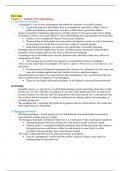Class notes
Chapter 2 - Models of Psychopathology
- Course
- PSYC 300A
- Institution
- University Of British Columbia (UBC )
Explore lecture notes on Models of Psychopathology. Gain insights into diverse theoretical models that explain the development and manifestation of psychological disorders. Examine various perspectives, such as the biological, psychodynamic, cognitive-behavioral, and sociocultural models. Discover ...
[Show more]



